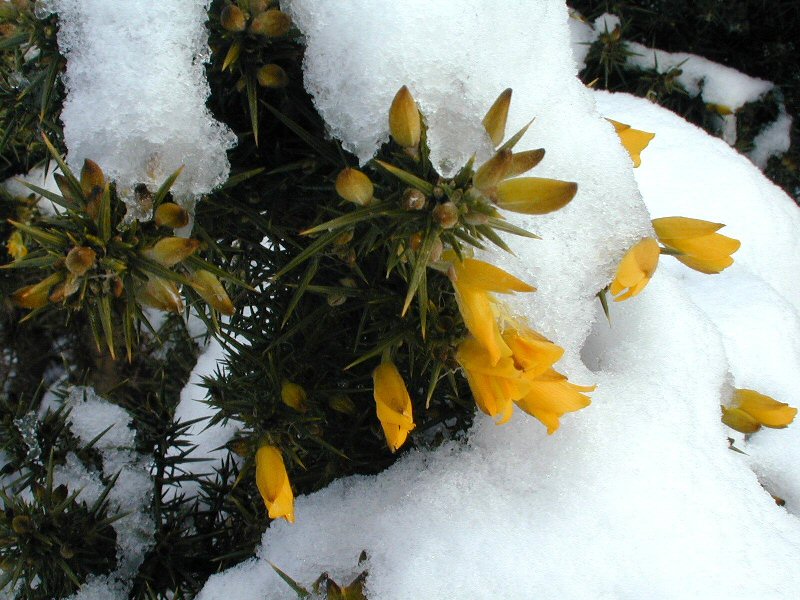- Gorse
image_width = 220px
image_caption = Dwarf Gorse
regnum =Plant ae
divisio = Magnoliophyta
classis =Magnoliopsida
ordo =Fabales
familia =Fabaceae
subfamilia =Faboideae
tribus =Genisteae
genus = "Ulex"
genus_authority = L.
subdivision_ranks = Species
subdivision = "Ulex argenteus" "Ulex boivinii" "Ulex borgiae" "Ulex cantabricus" "Ulex densus" "Ulex europaeus" -Common Gorse "Ulex gallii" -Dwarf Furze or Furse "Ulex genistoides" "Ulex micranthus" "Ulex minor" - Dwarf Gorse "Ulex parviflorus"Ref: [http://www.ildis.org/ ILDIS Version 6.05]Gorse ("Ulex") comprises a
genus of about 20 species ofevergreen shrub s in the subfamilyFaboideae of the pea familyFabaceae , native to westernEurope and northwestAfrica , with the majority of species in Iberia. Other common names for gorse include furse, whin and furze.Gorse is closely related to the brooms, and like them, has green stems and very small leaves and adapts to dry growing conditions, but differs in its extreme spininess, with the leaves being modified into 1-4 cm long spines. All the species have yellow flowers, some with a very long flowering season.
The most widely familiar species is the
Common Gorse ("Ulex europaeus"), the only species native in most of westernEurope , where it grows in sunny sites, usually on dry, sandy soils. It is also the largest species, reaching 2-3 m height; this compares with typically 0.2-0.4 m for Western gorse ("U. gallii"). This latter species is characteristic of highly exposed Atlantic coastal heathland and montane habitats.Common gorse flowers most strongly in spring, though it bears some flowers year round, hence the old country phrase: "When gorse is out of blossom, kissing's out of fashion." The flowers have a very distinctive strong
coconut scent. Western gorse orDwarf Furze differs in being almost entirely late summer flowering (August-September inIreland and Britain), and also have somewhat darker yellow flowers than Common gorse.Ecology
Gorse is a fire-climax plant, very well adapted to stand-replacing fires, being highly flammable, and having seed pods that are to a large extent opened by fire, thus allowing rapid regeneration after fire. The burnt stumps also readily sprout new growth from the roots. Where fire is excluded, gorse soon tends to be shaded out by taller-growing trees, unless other factors like exposure also apply. Typical fire recurrence periods in gorse stands are 5-20 years.
Gorse thrives in poor growing areas and conditions including drought; [Plants for a future, 2008] it is sometimes found on very rocky soils, [C.M. Hogan, 2008] where many species cannot thrive. Moreover, it is widely used for land reclamation (e.g., mine tailings), where its nitrogen-fixing capacity helps other plants establish better.
It is a valuable plant for wildlife, providing dense thorny cover ideal for protecting bird nests; in Britain,
France andIreland , it is particularly noted for supportingEuropean Stonechat s andDartford Warbler s. The flowers are sometimes eaten by thelarva of theDouble-striped Pug moth and another moth, "Coleophora albicosta" feeds exclusively on "Ulex".In many areas ofNorth America , southernSouth America ,Australia andNew Zealand , the Common Gorse, introduced as anornamental plant orhedge , has become naturalised and an invasiveweed due to its aggressive seed dispersal; it has proved very difficult to eradicate.As an invasive
Gorse is one of the most recognised agricultural weeds in New Zealand. Introduced from Western Europe in the very early stages of European settlement, it was recorded by
Charles Darwin during his voyage through New Zealand waters in1835 as growing in hedges in theBay of Islands . [K.Worsley, 1999] Its spread and development as a weed in this country's temperate climate was rapid but settlers failed to recognise the threat, and gorse seed continued to be imported and plantings deliberately established into the 1900s. Large spreading infestations over hundreds of hectares resulted, peaking in the late 1940s and costing past, present and future generations a great deal to clear and control. Gorse became New Zealand's most costly weed to control. Total eradication even with contemporary technology seems impossible. However, in New Zealand, it has been found to form a useful nursery for certain species for native bush regeneration. If gorse stands are left for several years, native seedlings generate in their shelter and grow up through the gorse, cutting out its light and eventually replacing it.Other aspects
Gorse flowers are edible and can be used in salads, tea and to make a non-grape based '
wine '. Gorse was used as animal feed in Scotland and Wales within the UK. It was "bruised" (crushed) by hand using mallets, or through hand or water driven mills and mixed with straw chaff to make fodder.The furse is the badge of the Sinclair and
MacLennan clans of Scotland.Furse is also a
Devon surname. Gorse itself is aLancashire surname .Line notes
References
* [http://www.pfaf.org/database/plants.php?Ulex+europaeus Plants for a Future, database entry for "Ulex europaeus"]
* C. Michael Hogan (2008) "Catto Long Barrow fieldnotes", Modern Antiquarian [http://letmespeaktothedriver.com/site/11227/catto.html#fieldnotes]
*External links
* [http://www.the-tree.org.uk/BritishTrees/TreeGallery/gorsec.htm Gorse on www.the-tree.org.uk ]
* [http://www.the-tree.org.uk/BritishTrees/MrsGrieve/mggorse.htm 'A Modern Herbal' (Grieves 1931)]
Wikimedia Foundation. 2010.

